Ards prone position Study guides, Class notes & Summaries
Looking for the best study guides, study notes and summaries about Ards prone position? On this page you'll find 357 study documents about Ards prone position.
Page 2 out of 357 results
Sort by
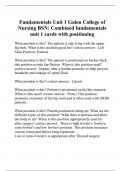
-
Fundamentals Unit 1 Galen College of Nursing BSN: Combined fundamentals unit 1 cards with positioning
- Exam (elaborations) • 36 pages • 2023
-
- $12.99
- + learn more
What position is this? The patient is side lying with the upper leg bent. What is the position good for? correct answer: Left Sims Position; Enemas What position is this? The patient is positioned on his/her back; this position avoids hip flexion. When is this position used? correct answer: Supine; after a lumbar puncture to help prevent headache and leakage of spinal fluid. What position is this? correct answer: Lateral What position is this? Patient is positioned on his/her stomach...
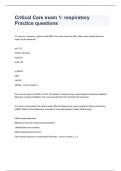
-
Critical Care exam 1 respiratory Practice questions with complete solution 2024
- Exam (elaborations) • 26 pages • 2024
- Available in package deal
-
- $13.99
- + learn more
Critical Care exam 1 respiratory Practice questions with complete solution 2024 1) A nurse is caring for a patient with ARDS. The nurse views the ABG. What value should the nurse report to the physician? pH: 7.35 PaCO2: 26mmhg PaO2:95 HCO3: 22 a) PaCO2 b)pH c)HCO3 d)PaO2 - correct answer a The normal range for PaCO2 is 35-45. This patient is experiencing a superimposed respiratory alkalosis likely due to hyperventilation. The nurse should report the PaCO2 to the physician. 2) ...
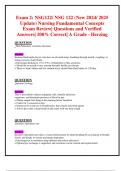
-
Exam 2: NSG122/ NSG 122 (New 2024/ 2025 Update) Nursing Fundamental Concepts Exam Review| Questions and Verified Answers| 100% Correct| A Grade - Herzing
- Exam (elaborations) • 20 pages • 2024
- Available in package deal
-
- $10.99
- + learn more
Exam 2: NSG122/ NSG 122 (New 2024/ 2025 Update) Nursing Fundamental Concepts Exam Review| Questions and Verified Answers| 100% Correct| A Grade - Herzing QUESTION Thin Pulmonary secretion education Increase fluid intake for pts who have an elevated temp; breathing through mouth; coughing; or losing excessive body fluids o Encourage drinking at 1.9 to 2.9 L of fluids/day to thin secretions o Should be increased to max amount that pt9s health can tolerate o Those w/ heart failure a...

-
NBRC Book Exam Review Questions With Complete Solutions
- Exam (elaborations) • 77 pages • 2023
- Available in package deal
-
- $13.99
- + learn more
VCV for ARDS patients leads to high ____ and an increased potential of barotrauma by ______. correct answer: -peak pressures -overdistention of the alveoli A patient with pneumonia is performing PEP therapy. A PEP level of 17 cm H2O is generated during each exhalation. The therapist should: correct answer: -maintain current therapy Normal level is between 10-20cmH2O For ARDS patients, using inspiratory pressures that deliver lower _____ and maintaining plateau pressures at ____ will...
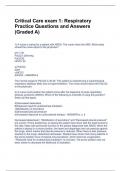
-
Critical Care exam 1: Respiratory Practice Questions and Answers (Graded A)
- Exam (elaborations) • 19 pages • 2023
- Available in package deal
-
- $11.49
- + learn more
Critical Care exam 1: Respiratory Practice Questions and Answers (Graded A)Critical Care exam 1: Respiratory Practice Questions and Answers (Graded A)Critical Care exam 1: Respiratory Practice Questions and Answers (Graded A)Critical Care exam 1: Respiratory Practice Questions and Answers (Graded A) 1) A nurse is caring for a patient with ARDS. The nurse views the ABG. What value should the nurse report to the physician? pH: 7.35 PaCO2: 26mmhg PaO2:95 HCO3: 22 a) PaCO2 b)pH c)HCO3 d...
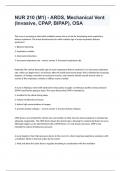
-
NUR 210 (M1) - ARDS, Mechanical Vent (Invasive, CPAP, BIPAP), OSA with complete solutions 2024
- Exam (elaborations) • 25 pages • 2024
- Available in package deal
-
- $17.99
- + learn more
NUR 210 (M1) - ARDS, Mechanical Vent (Invasive, CPAP, BIPAP), OSAThe nurse is assessing a client with multiple trauma who is at risk for developing acute respiratory distress syndrome. The nurse should assess for which earliest sign of acute respiratory distress syndrome? 1. Bilateral wheezing 2. Inspiratory crackles 3. Intercostal retractions 4. Increased respiratory rate - correct answer 4. Increased respiratory rate Rationale:The earliest detectable sign of acute respiratory distress s...
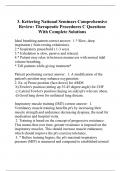
-
3. Kettering National Seminars Comprehensive Review: Therapeutic Procedures C Questions With Complete Solutions
- Exam (elaborations) • 32 pages • 2023
- Available in package deal
-
- $12.99
- + learn more
Ideal breathing pattern correct answer: 1.* Slow, deep inspiration ( from resting exhalation). 2.* Inspiratory pause/hold ( 1-3 secs) 3.* Exhalation is slow, passive and relaxed. 4.* Patient may relax in between maneuvers with normal tidal volume breathing. * Tell patients while giving treatment* Patient positioning correct answer: 1. A modification of the patient's position may enhance oxygenation 2. Ex: a) Prone position (face down) for ARDS b) Fowler's position (sitting up 35-45...

-
ARDS/VENTS questions well answered 2024
- Exam (elaborations) • 6 pages • 2024
- Available in package deal
-
- $12.99
- + learn more
ARDS/VENTSARDS: Medical Management - correct answer 1) PEEP 2) Positive Pressure Mechanical Ventilation 3) Position changes- prone and continuous lateral rotation 4) fluid mgt 5) meds- don't really work but still here they are: -corticosteroids -inhaled Nitric Oxide -surfactant replacement -partial liquid ventilation -neuromuscular blocking agents -nutrition with enteral formulas 6) giving carbon dioxide (hypercapnia) PEEP - correct answer positive end expiratory pressure mechani...

-
Critical Care exam 1: respiratory Practice questions & Answers 2023
- Exam (elaborations) • 19 pages • 2023
- Available in package deal
-
- $12.99
- + learn more
1) A nurse is caring for a patient with ARDS. The nurse views the ABG. What value should the nurse report to the physician? pH: 7.35 PaCO2: 26mmhg PaO2:95 HCO3: 22 a) PaCO2 b)pH c)HCO3 d)PaO2 - ANSWERSa The normal range for PaCO2 is 35-45. This patient is experiencing a superimposed respiratory alkalosis likely due to hyperventilation. The nurse should report the PaCO2 to the physician. 2) A nurse must position the patient prone after his diagnosis of acute respiratory distress...

-
Ch 32 - ARF & ARDS QUESTIONS WITH CORRECT ANSWERS 2024
- Exam (elaborations) • 13 pages • 2024
- Available in package deal
-
- $19.49
- + learn more
Ch 32 - ARF & ARDS QUESTIONS WITH CORRECT ANSWERS 2024 C Arterial blood gas (ABG) analysis is the most specific information because ventilatory failure causes problems with CO2 retention, and ABGs give information about the PaCO2 and pH. Chest x-ray, oxygen saturation, and central venous pressure monitoring may also be done to help in assessing oxygenation or determining the cause of the patient's ventilatory failure. Which diagnostic test would provide the nurse with the most specific infor...

Did you know that on average a seller on Stuvia earns $82 per month selling study resources? Hmm, hint, hint. Discover all about earning on Stuvia


